Pyramidal Pinhole Glasses
Scratch-resistant, square pinhole glasses arranged in a pyramid shape in curved lenses.
Experience shows that these full-surface Pinhole Glasses are preferred for prescriptions under 2.0 diopters and serve as a preventive measure for people who do not normally wear glasses.
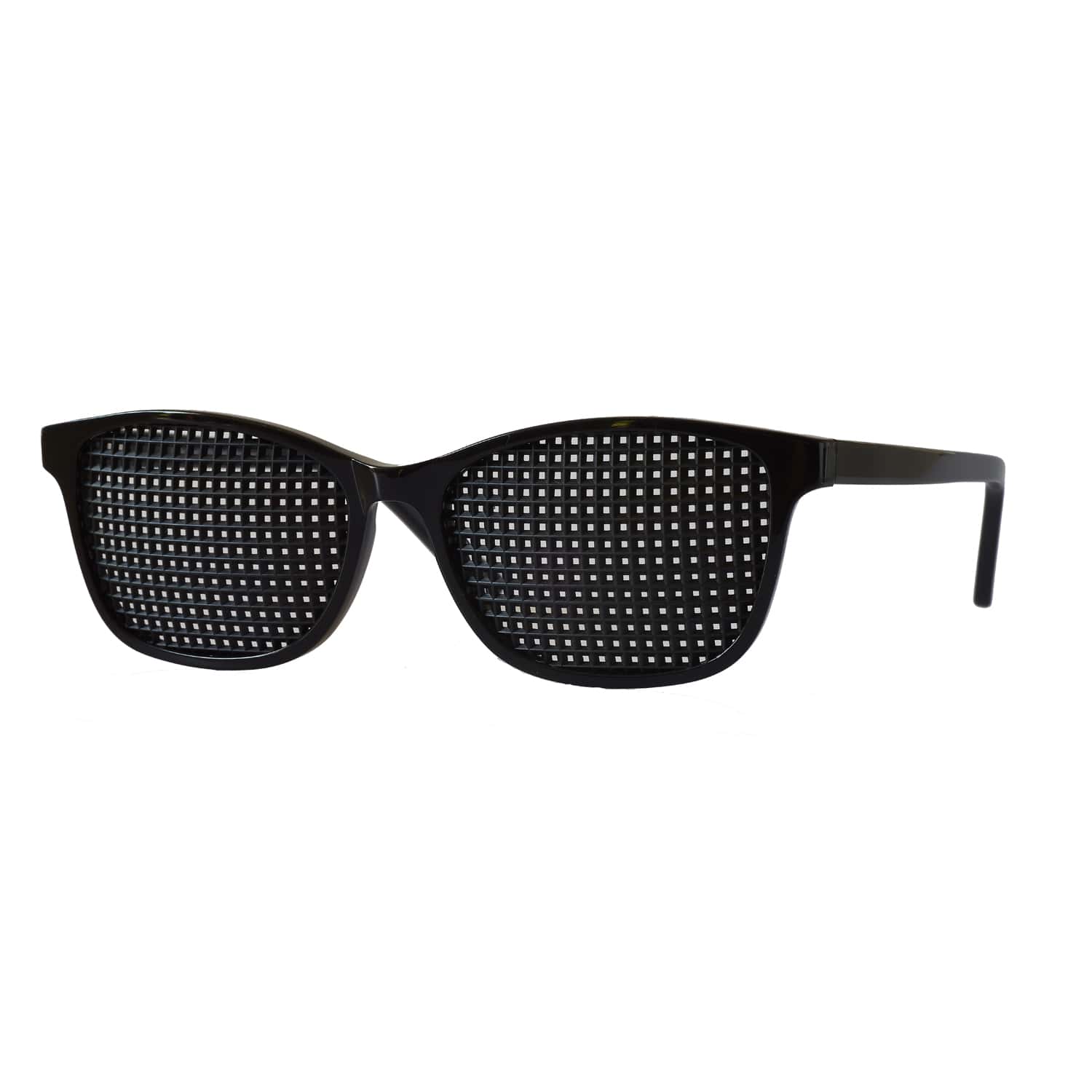
Organic Cotton Pinhole Glasses ACEP
DimensionsScope of deliveryFrame width: 130 mmPinhole GlassesArm length: 140 mmSpectacle caseBridge width: 15 mmOriginal Visus eye chart, the ideal aid for monitoring the progress of your eye trainingWeight: 20 gDetailed spectacle descriptionRaster height: 35 mmGrid length: 53 mmFirst pinhole glasses made from organic materials Design The first pinhole glasses made from organic materials! Sustainably manufactured using traditional craftsmanship, they combine the highest standards of quality and comfort. Permanently dimensionally stable Easy to clean Insensitive to moisture and temperature fluctuations Advantages over conventional glasses Very lightweight Silky sheen Optimal comfort without pressure points on the bridge of the nose Environmentally friendly, recyclable material Easy to repair Grid Pyramid-shaped, scratch-resistant, square grid on curved lenses. Experience shows: This full-surface grid is preferred for prescriptions below 2.0 dioptres and serves as a preventive measure for people who do not wear spectacles. Use For effective eye training: practise for 10–20 minutes daily with the grid or Multidot glasses. Ideal during everyday activities: Long-sighted people: while reading Short-sighted people: while watching television, working at a computer screen or walking in the distance Benefits The physical pinhole effect supports clear vision. The brain activates the eye muscles to focus independently – a function that normal glasses often do not train. Design Purist unisex design with durable metal spring hinges. The velvety-silky sheen of the black frame combines aesthetics with environmental awareness. Eye health in everyday life Traditional vision exercises are time-consuming and require discipline. Pinhole glasses enable effective training alongside everyday tasks such as working on the computer. Intelligent vision training Modern working conditions place a one-sided strain on the eyes: Adaptation performance: light-dark adjustment Accommodation performance: near-far focusing The pinhole glasses break through this one-sided strain and promote natural, active vision. Origin of eye training according to William Bates William Bates proved that visual acuity depends on the activity of the six external eye muscles, not on the eye lens. In 1920, he published Perfect Sight Without Glasses and developed the Bates Method. Later, Janet Goodrich built on this and published the first studies on grid and pinhole glasses. Product information Manufacturer: BioTec Dr. Egely & Lobmayer GmbH Sendlingerstr. 8, 84332 Hebertsfelden, Germany Telephone: +49 8721 910939 Email: info@biotec7.de Safety and warning information The glasses must not be worn in road traffic. Clean only with mild cleaning agents. Aggressive agents or improper handling can damage the glasses.
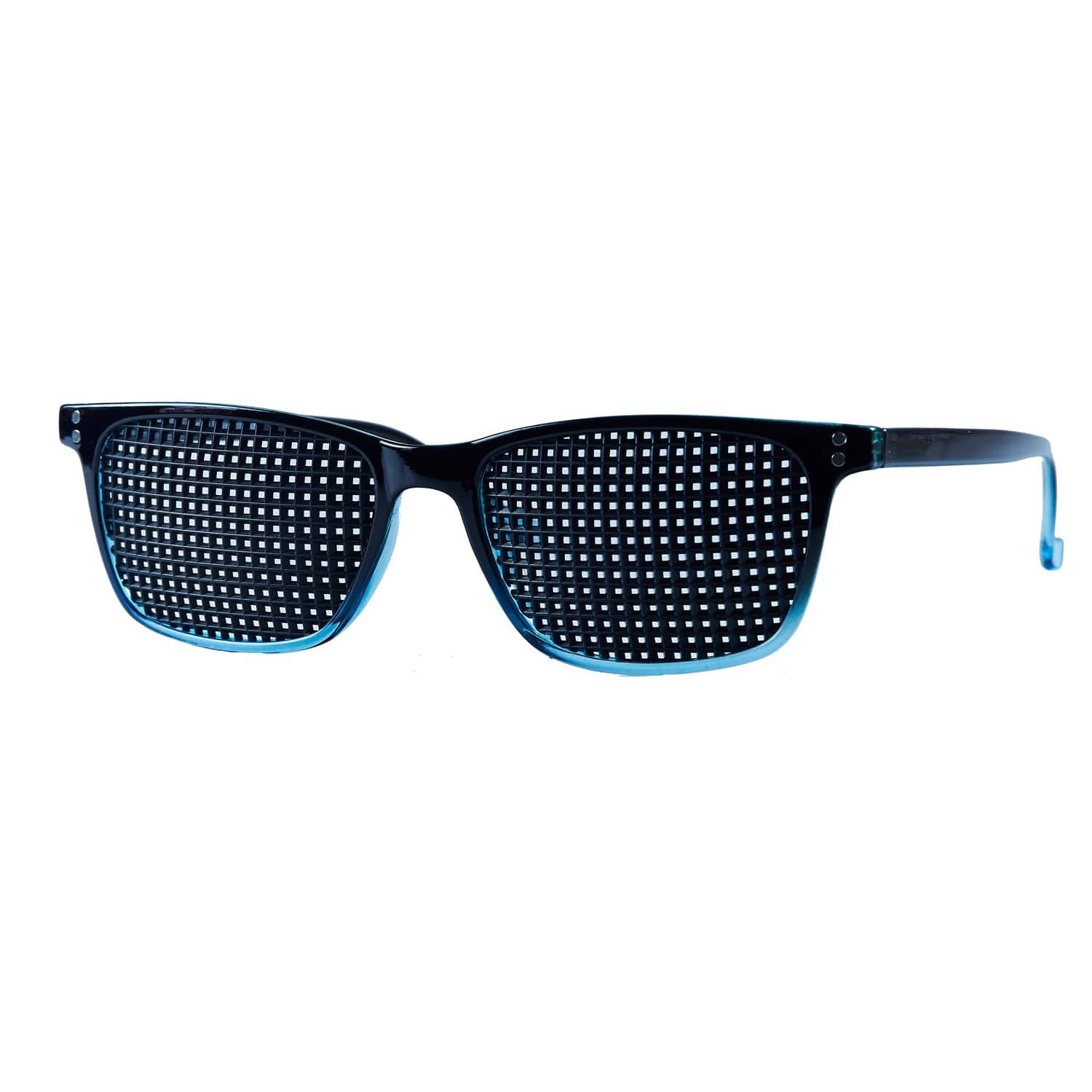
Pinhole Glasses ABP
DimensionsScope of deliveryFrame width: 140 mmPinhole GlassesTemple length: 140 mmSpectacle caseBridge width: 17 mmOriginal Visus eye chart, the ideal aid for monitoring the progress of your eye trainingWeight: 14 gDetailed spectacle descriptionRaster height: 35 mmGrid length: 55 mmABP grid glasses – targeted eye training Grid: pyramidal grid A scratch-resistant, square grid arranged in a pyramid shape is integrated into curved lenses. This full-surface grid is preferred for less than 2.0 dioptres and serves as prevention for non-spectacle wearers. Use A daily training session of 10–20 minutes is sufficient. The Pinhole Glasses can be perfectly integrated into everyday life: At work When reading When watching television They support both short-sighted and long-sighted people, depending on their individual vision needs. Benefits Training with pinhole glasses actively stimulates the eye. In contrast to passive corrective glasses, pinhole glasses challenge the eye muscles. Supported by the pinhole effect and the central nervous system, natural focusing is reactivated. Design High-quality plastic frame in a slightly rectangular shape with a modern black-blue colour gradient. Two subtle metal decorations on the outer frame and a durable spring hinge ensure a good fit for any head size and a high-quality look. Eye health in everyday life Traditional vision exercises are time-consuming. Pinhole glasses allow for effective training alongside everyday activities such as working on the computer, reading or going for a walk. Intelligent vision training Modern working conditions place a one-sided strain on the eyes: Adaptation performance: light-dark adjustment Accommodation performance: near-far focusing Pinhole glasses break this one-sided strain and enable active, natural vision. History of eye training according to William Bates William Bates showed that visual acuity is determined by the activity of the six external eye muscles. In 1920, he published Perfect Sight Without Glasses and developed the Bates Method. Later, Janet Goodrich conducted the first studies on grid and pinhole glasses. Product information Manufacturer: BioTec Dr. Egely & Lobmayer GmbH Sendlingerstr. 8, 84332 Hebertsfelden, Germany Telephone: +49 8721 910939 Email: info@biotec7.de Safety and warning instructions Do not use in road traffic. Clean only with mild cleaning agents. Aggressive agents or improper handling can damage the glasses.
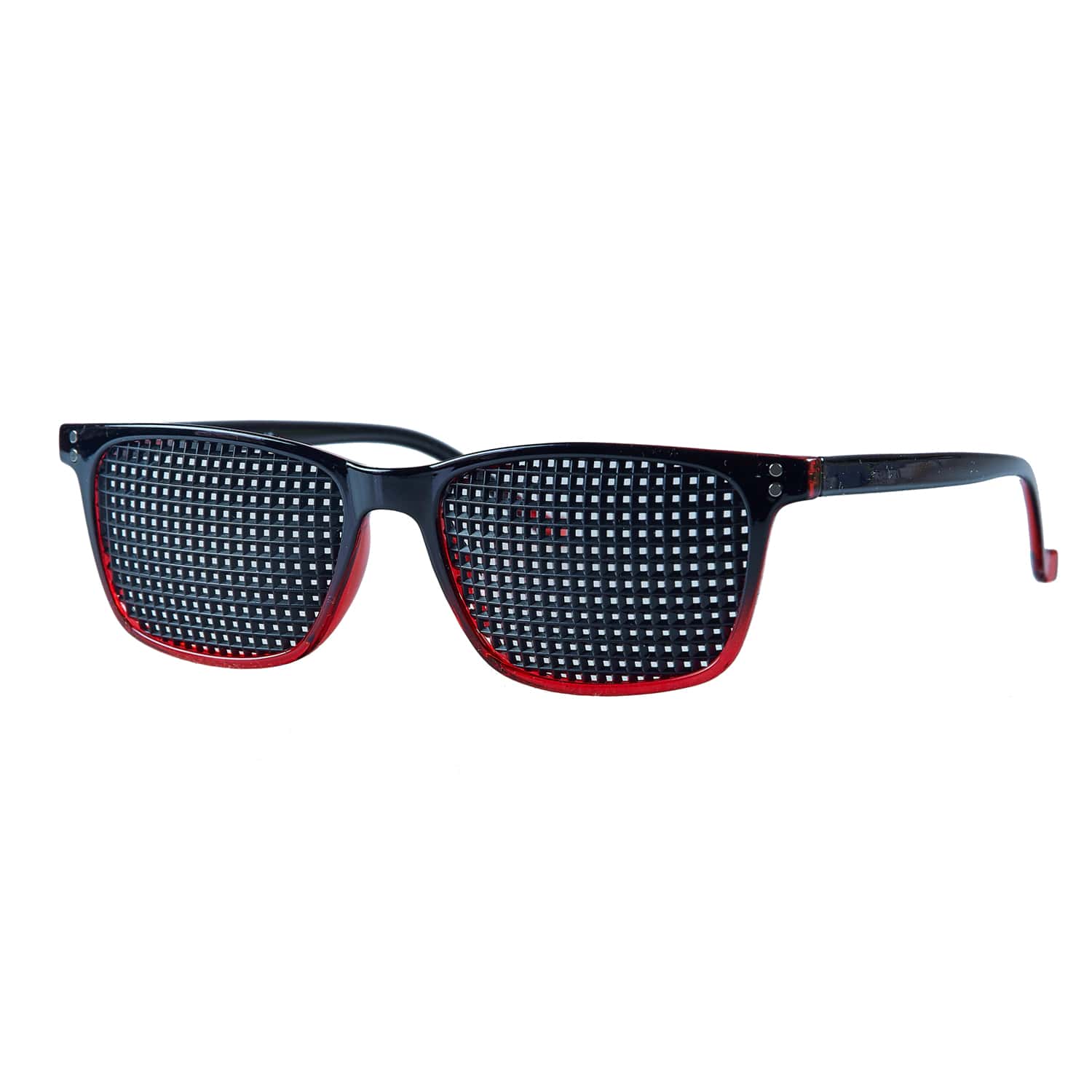
Pinhole Glasses ARP
DimensionsScope of deliveryFrame width: 140 mmPinhole GlassesTemple length: 140 mmSpectacle caseBridge width: 17 mmOriginal Visus eye chart, the ideal aid for monitoring the progress of your eye trainingWeight: 14 gDetailed spectacle descriptionRaster height: 35 mmGrid length: 55 mmGrid: pyramidal grid The curved lenses have a scratch-resistant, square grid arranged in a pyramid shape. This grid is preferred for prescriptions under 2.0 dioptres and is particularly suitable for people who do not wear glasses as a preventive measure. Use: Train your eyes for 10–20 minutes every day with pinhole glasses. Ideal for all everyday activities at home and at work. For long-sighted people, they support close-up vision, for example when reading. Short-sighted people can keep their eyes active when watching television, working at a screen or looking into the distance, e.g. with multidot glasses. Benefits: Thanks to the pinhole effect, Pinhole Glasses enable almost sharp vision, while the eye muscles are activated by neural stimuli. This keeps the eye muscles active and strong, in contrast to the passive relief provided by conventional glasses. Design: Slightly rectangular plastic frame with high-quality workmanship and an elegant black and reddish color gradient. Two delicate metal decorations on the outer frame and a durable spring hinge ensure optimal adjustment to any head size. Eye health in modern times: Traditional vision exercises are often time-consuming and require consistent training. Pinhole glasses enable effective vision training during modern multitasking activities – e.g. when working on a computer. Eye training: a smart alternative for vision problems Our eyes are often overstrained by one-sided strain in the modern working world – whether it's adjusting to light and dark situations or switching between near and far vision. Raster glasses training breaks through this one-sidedness and supports natural vision. The origin according to William Bates: William Bates proved through numerous experiments that visual acuity does not primarily depend on the lens of the eye, but on the activity of the six external eye muscles. In 1920, he published his findings in ‘Perfect Sight Without Glasses’. The Bates method developed from this forms the basis for training with pinhole glasses. Later, vision trainer Janet Goodrich expanded on the method and published studies on pinhole glasses. Additional product information: Manufacturer: BioTec Dr. Egely & Lobmayer GmbH, Sendlingerstr. 8, 84332 Hebertsfelden, Germany, Telephone: +49 8721 910939, Email: info@biotec7.de Warnings and safety instructions: Do not use in road traffic. Aggressive cleaning agents or improper handling can damage the glasses.

Pinhole Glasses CSP
DimensionsScope of deliveryFrame width: 145 mmPinhole GlassesTemple length: 135 mmGlasses caseBridge width: 16 mmOriginal Visus eye chart, the ideal aid for monitoring the progress of your eye trainingWeight: 16 gDetailed description of glassesGrid height: 35 mmGrid length: 55 mmGrid: pyramidal grid The curved lenses have a scratch-resistant, square grid arranged in a pyramid shape. This grid is preferred for prescriptions under 2.0 dioptres and is particularly suitable for people who do not wear glasses as a preventive measure. Use: Daily training with Pinhole Glasses or multidot glasses for 10–20 minutes is sufficient. Use the glasses consistently for routine tasks at home or at work. Farsighted people benefit when reading, while nearsighted people can improve their eyesight when watching television or taking walks and looking into the distance. Benefits: Pinhole Glasses offer a holistic training method for the eyes. The physical pinhole effect enables almost sharp vision, while the brain stimulates the eye muscles to actively focus – without the need for optical lenses. Design: The silver-coloured frame combines straight lines in the upper viewing area with slightly rounded ends. It impresses with its robustness and high wearing comfort. Unisex, with reinforced plastic ends and silicone nose pads for optimal fit. Eye health in our hectic times Traditional vision exercises are time-consuming and require consistent training. Pinhole glasses support effective vision training during modern multitasking activities – e.g. when working on a computer. Eye training – an intelligent alternative for visual impairments In the modern working world, eyes are often exposed to one-sided strain – whether it's adjusting to light and dark or switching between near and far vision. Training with pinhole glasses breaks through this one-sidedness and promotes natural vision. The origin according to William Bates: William Bates demonstrated through numerous experiments that visual acuity depends primarily not on the lens of the eye, but on the activity of the six external eye muscles. In 1920, he published his findings in ‘Perfect Sight Without Glasses’. The Bates method developed from this forms the basis for training with pinhole glasses. Later, vision trainer Janet Goodrich expanded on the method and published studies on pinhole glasses. Additional product information: Manufacturer: BioTec Dr. Egely & Lobmayer GmbH, Sendlingerstr. 8, 84332 Hebertsfelden, Germany, Telephone: +49 8721 910939, Email: info@biotec7.de Warnings and safety instructions: Do not use in road traffic. Aggressive cleaning agents or improper handling can damage the glasses.

Pinhole Glasses DSP
DimensionsScope of deliveryFrame width: 140 mmPinhole GlassesTemple length: 145 mmSpectacle caseBridge width: 20 mmOriginal Visus eye chart, the ideal aid for monitoring the progress of your eye trainingWeight: 15 gDetailed spectacle descriptionRaster height: 40 mmGrid length: 50 mmGrid: pyramidal grid The curved lenses feature a scratch-resistant, square grid arranged in a pyramid shape. This full-surface grid is preferred for prescriptions under 2.0 dioptres and is particularly suitable for people who do not wear glasses as a preventive measure. Use: For effective eye training, wear the Pinhole Glasses or multidot glasses for 10–20 minutes every day. Integrate them into your everyday activities at home or at work. People who are long-sighted benefit when reading, while those who are short-sighted train their eyes when watching television or looking into the distance, for example during a walk. Benefits: The pinhole glasses train the eye in a natural way. The pinhole effect creates almost sharp vision, while the brain stimulates the eye muscles to adjust the focus independently again. This keeps the muscles active and flexible. Design: The silver-coloured spectacle frame in a classic panto style – oval at the top, round at the bottom – combines durability with minimal weight (only 15 g). Silicone nose pads and plastic reinforcements at the ends of the arms ensure high wearing comfort without pressure points. Unisex design with a striking nose bridge. Maintaining eye health in our hectic times Traditional vision exercises require a lot of time and discipline. Training with pinhole glasses supports modern multitasking: you can complete your daily vision training while working on the computer or performing routine tasks. Eye training – an intelligent alternative for visual impairments In the modern working world, our eyes are often subjected to one-sided strain, whether it be adjusting to light and dark or switching between near and far vision. Training with pinhole glasses breaks through this one-sidedness and promotes natural vision. The origins of eye training according to William Bates William Bates proved through numerous experiments that visual acuity does not primarily depend on the lens of the eye, but on the activity of the six external eye muscles. In 1920, he published his findings in ‘Perfect Sight Without Glasses’. The Bates method developed from this forms the basis for training with pinhole glasses. Later, vision trainer Janet Goodrich expanded on the method and published studies on pinhole and pinhole glasses. Additional product information: Manufacturer: BioTec Dr. Egely & Lobmayer GmbH, Sendlingerstr. 8, 84332 Hebertsfelden, Germany, Telephone: +49 8721 910939, Email: info@biotec7.de Warnings and safety instructions: Do not use in road traffic. Aggressive cleaning agents or improper handling may damage the glasses.

Pinhole Glasses EGP
DimensionsScope of deliveryFrame width: 130 mmPinhole GlassesTemple length: 135 mmSpectacle caseBridge width: 16 mmOriginal Visus eye chart, the ideal aid for monitoring the progress of your eye trainingWeight: 18 gDetailed spectacle descriptionRaster height: 40 mmGrid length: 50 mmGrid: pyramidal grid The curved lenses feature a scratch-resistant, square grid arranged in a pyramid shape. This full-surface grid is preferred for prescriptions under 2.0 dioptres and is particularly suitable for people who do not wear glasses as a preventive measure. Use: For targeted eye training, wear the Pinhole Glasses or multidot glasses for 10–20 minutes every day. Ideal for everyday activities at home or at work. Long-sighted people use the glasses when reading, while short-sighted people use them to improve their eyesight when working at a computer screen, watching television or going for walks. Benefits: The pinhole glasses support vision in a natural way. The pinhole effect creates almost sharp vision, while the brain activates the eye muscles to adjust the focus independently. This trains the muscles instead of passively relieving them. Design: The high-quality, gold-coloured metal frame impresses with its elegance and comfort. Silicone nose pads and reinforced plastic ends ensure a comfortable fit, suitable for both men and women. Maintaining eye health in our hectic times Traditional vision exercises are time-consuming and require discipline. Pinhole glasses enable modern vision training while multitasking: you can complete your daily training while working on the computer or doing routine tasks, for example. Eye training – an intelligent alternative for visual impairments In the modern working world, our eyes are often subjected to one-sided strain, whether it be adjusting to light and dark or switching between near and distant vision. Training with pinhole glasses breaks through this one-sidedness and promotes natural vision. The origin of eye training according to William Bates William Bates proved through numerous experiments that visual acuity does not primarily depend on the lens of the eye, but on the activity of the six external eye muscles. In 1920, he published his findings in ‘Perfect Sight Without Glasses’. The Bates method developed from this forms the basis for training with pinhole glasses. Later, vision trainer Janet Goodrich expanded on the method and published studies on pinhole and pinhole glasses. Additional product information: Manufacturer: BioTec Dr. Egely & Lobmayer GmbH, Sendlingerstr. 8, 84332 Hebertsfelden, Germany, Telephone: +49 8721 910939, Email: info@biotec7.de Warnings and safety instructions: Do not use in road traffic. Aggressive cleaning agents or improper handling may damage the glasses.
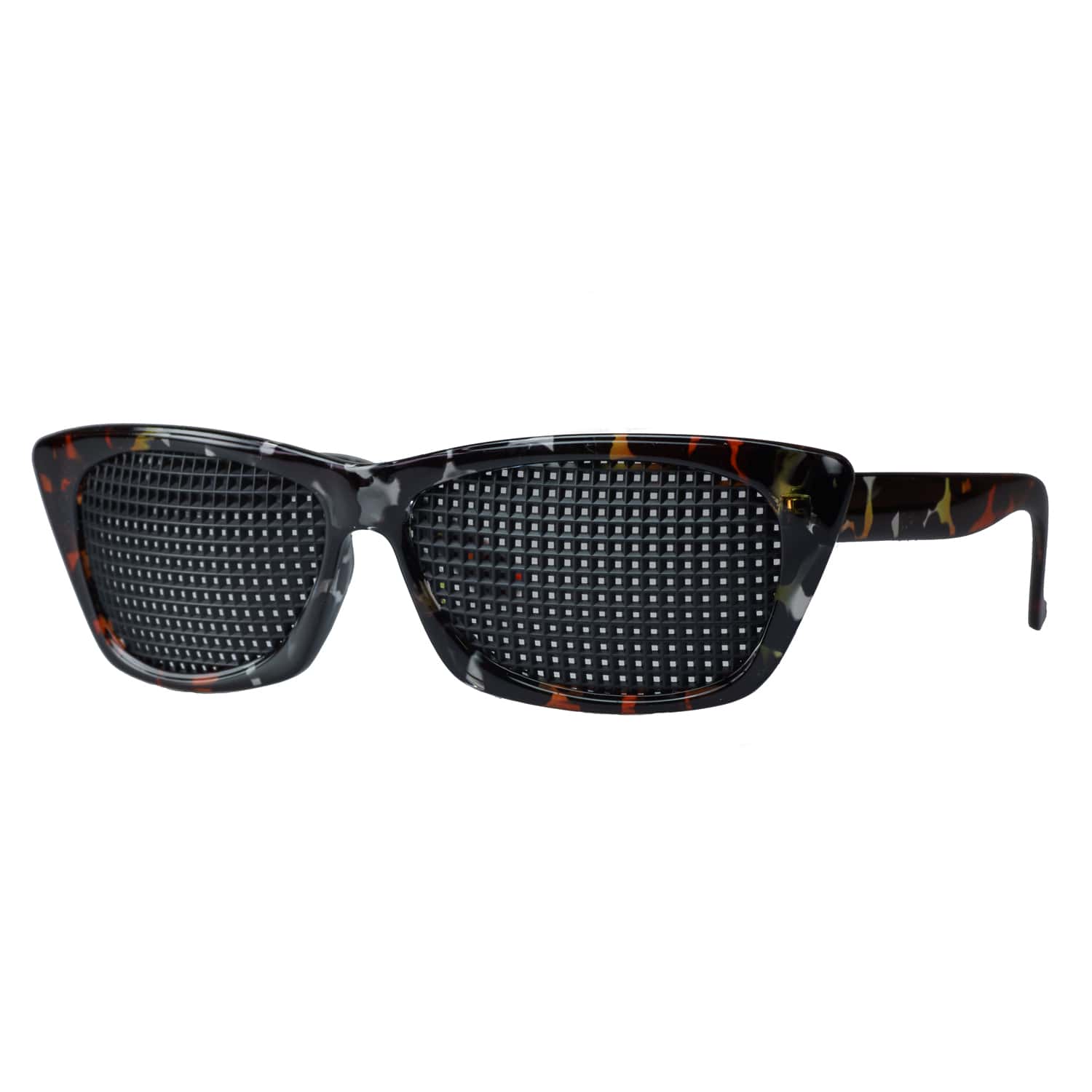
Pinhole Glasses FMP
DimensionsScope of deliveryFrame width: 140 mmPinhole GlassesTemple length: 130 mmGlasses caseBridge width: 15 mmOriginal Visus eye chart, the ideal aid for monitoring the progress of your eye trainingWeight: 21 gDetailed description of glassesGrid height: 40 mmGrid length: 70 mmGrid: pyramidal grid The curved lenses feature a scratch-resistant, square grid arranged in a pyramid shape. This full-surface grid is preferred for prescriptions under 2.0 dioptres and is used by non-spectacle wearers for prevention. Use: For targeted vision training, wear the Pinhole Glasses or multidot glasses for 10–20 minutes every day. Ideal for routine tasks at home or at work. People with long-sightedness use the glasses for close-up work, e.g. reading, while people with short-sightedness activate their eyes when watching television, working at a screen or going for walks. Benefits: Thanks to the pinhole effect, the glasses enable almost sharp vision, while the brain activates the eye muscles, thus reactivating natural vision. In contrast to conventional glasses, the muscles remain active and trained. Design: The stylish, brown-tigered model impresses with a feminine design that tapers off at the top of the frame and a solid frame. The workmanship ensures high wearing comfort and at the same time makes the glasses an attractive fashion accessory. Maintaining eye health in our hectic times Traditional vision exercises are time-consuming and require discipline. Training with pinhole glasses supports modern ‘multitasking’: you can complete your daily vision training while working on the computer or performing routine tasks. Eye training – an intelligent alternative for visual impairments In today's working world, the eyes are often subjected to one-sided strain, both in terms of light-dark adjustments and near-far changes. Training with pinhole glasses breaks through this one-sidedness and promotes natural vision. The origin of eye training according to William Bates William Bates proved that visual acuity depends not only on the lens of the eye, but also on the activity of the six external eye muscles. In 1920, he published his findings in ‘Perfect Sight Without Glasses’. His method is based on simple eye exercises, which were later expanded upon by vision trainer Janet Goodrich and investigated in studies on grid and pinhole glasses. Additional product information: Manufacturer: BioTec Dr. Egely & Lobmayer GmbH, Sendlingerstr. 8, 84332 Hebertsfelden, Germany, Telephone: +49 8721 910939, Email: info@biotec7.de Warnings and safety instructions: Do not use in road traffic. Improper cleaning or aggressive cleaning agents can damage the glasses.

Pinhole Glasses FSP
DimensionsScope of deliveryFrame width: 140 mmPinhole GlassesTemple length: 130 mmGlasses caseBridge width: 15 mmOriginal Visus eye chart, the ideal aid for monitoring the progress of your eye trainingWeight: 21 gDetailed description of glassesGrid height: 40 mmGrid length: 70 mmGrid: pyramidal grid The curved lenses have a scratch-resistant, square grid arranged in a pyramid shape. Experience shows that this full-surface grid is preferred for less than 2.0 dioptres and serves as prevention for non-spectacle wearers. Use: 10 to 20 minutes of daily training is sufficient: wear the Pinhole Glasses or multidot glasses during your routine tasks at home or at work. Long-sighted people use the glasses for close-up tasks such as reading, while short-sighted people activate their eyes when watching television or relaxing and looking into the distance, e.g. when going for a walk. Benefits: The pinhole glasses use the physical pinhole effect, which enables almost sharp vision – without the need for ground lenses. At the same time, the brain stimulates the eye muscles, training natural vision and keeping the muscles flexible. Design: The shiny black model with an angular upper frame and solid frame combines stylish design with high stability. Reinforced frame ends and silicone nose pads ensure comfortable wear. An attractive, fashionable accessory for men and women. Maintaining eye health in our hectic times Traditional vision exercises are time-consuming and require discipline. With pinhole glasses, you can integrate daily vision training into your everyday life – while working on the computer or performing other routine tasks – and thus actively prevent visual impairments. Eye training – an intelligent alternative for visual impairments In modern working life, our eyes are often subjected to one-sided strain, for example when adjusting to light and dark or switching between near and far vision. Pinhole glasses break through this one-sidedness and promote natural vision. The origins of eye training according to William Bates William Bates proved that visual acuity does not depend solely on the lens of the eye, but also on the activity of the six external eye muscles. In 1920, he published his findings in ‘Perfect Sight Without Glasses’. His method is based on simple eye exercises, which were later expanded upon by vision trainer Janet Goodrich and investigated in studies on grid and pinhole glasses. Additional product information: Manufacturer: BioTec Dr. Egely & Lobmayer GmbH, Sendlingerstr. 8, 84332 Hebertsfelden, Germany, Telephone: +49 8721 910939, Email: info@biotec7.de Warnings and safety instructions: Do not use in road traffic. Improper cleaning or aggressive cleaning agents can damage the glasses.

Pinhole Glasses GAP
DimensionsScope of deliveryFrame width: 135 mmPinhole GlassesArm length: 145 mmSpectacle caseBridge width: 20 mmOriginal Visus eye chart, the ideal aid for monitoring the progress of your eye trainingWeight: 17 gDetailed spectacle descriptionRaster height: 35 mmGrid length: 50 mmGrid: pyramidal grid The curved lenses feature a scratch-resistant, square grid arranged in a pyramid shape. Studies show that this grid is preferred for prescriptions under 2.0 dioptres and serves as a preventative measure for people who do not wear glasses. Use: Train your eyes for 10–20 minutes every day with Pinhole Glasses or multidot glasses. Ideal for everyday tasks: long-sighted people wear the glasses when reading, short-sighted people when watching television, working at a screen or relaxing and looking into the distance, for example during a walk. Benefits: The pinhole effect of the glasses ensures almost sharp vision, while the brain sends signals to the eye muscles. This promotes the natural visual process, keeps the eyes active and relieves strain on the retina at the same time. Design: The silver-anodised metal frame combines style and comfort and is unisex. High-quality workmanship, soft silicone nose pads and reinforced plastic ends ensure comfortable wear throughout the day. Eye health in hectic times Traditional vision exercises are often time-consuming and require discipline. With pinhole glasses, daily training can be easily integrated into everyday life – while working on the computer or performing other routine tasks – thus supporting long-term vision. Eye training – natural vision improvement The modern working world puts a strain on our eyes in one direction: light-dark adjustment and near-far switching are particularly challenging. Pinhole glasses break through this one-sidedness and train natural vision. The origin of eye training according to William Bates William Bates proved that visual acuity does not depend solely on the lens of the eye, but also on the activity of the six external eye muscles. In 1920, he published his findings in ‘Perfect Sight Without Glasses’. His methods were further developed by vision trainer Janet Goodrich and scientifically researched for grid and pinhole glasses. Additional product information: Manufacturer: BioTec Dr. Egely & Lobmayer GmbH, Sendlingerstr. 8, 84332 Hebertsfelden, Germany, Telephone: +49 8721 910939, Email: info@biotec7.de Warnings and safety instructions: Do not use while driving. Improper cleaning or aggressive cleaning agents can damage the glasses.
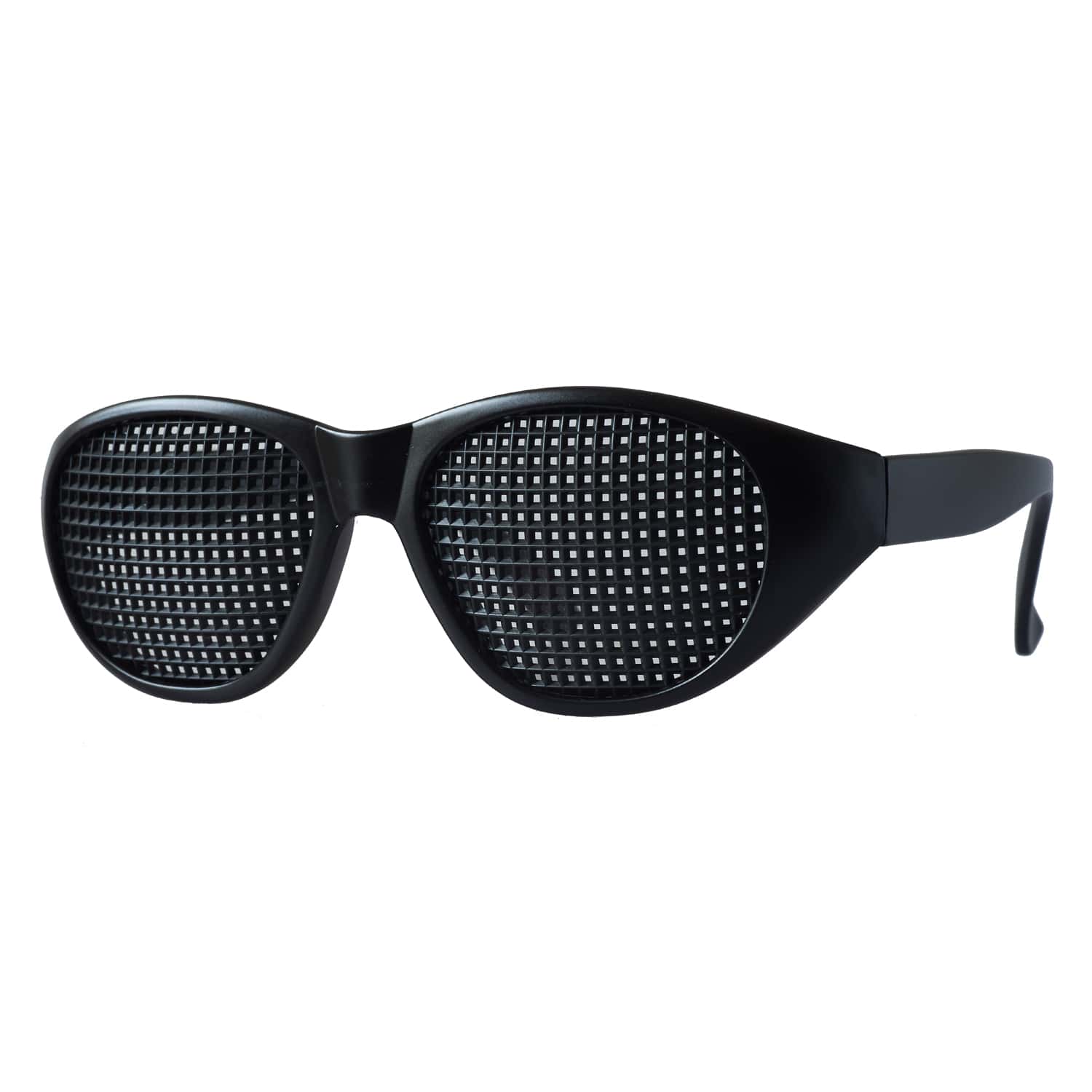
Pinhole Glasses JGP
DimensionsScope of deliveryFrame width: 140 mmPinhole GlassesArm length: 120 mmSpectacle caseBridge width: 15 mmOriginal Visus eye chart, the ideal aid for monitoring the progress of your eye trainingWeight: 23 gDetailed spectacle descriptionRaster height: 40 mmGrid length: 50 mmGrid: pyramidal grid The curved lenses feature a scratch-resistant, square grid arranged in a pyramid shape. Experience shows that this grid is preferred for prescriptions under 2.0 dioptres and serves as a preventative measure for people who do not wear glasses. Use: For effective vision training, it is sufficient to wear the Pinhole Glasses or multidot glasses for 10–20 minutes a day. Ideal for everyday tasks at home or at work: long-sighted people use them for reading, short-sighted people for watching television, working at a screen or relaxing and looking into the distance, for example during a walk. Benefits: The pinhole glasses activate natural vision. The pinhole effect enables almost sharp vision, while the brain stimulates the eye muscles. This keeps the eye mobile and allows it to respond to natural visual stimuli again. Design: The robust black matte panto-style frame is slightly oval at the top and rounded at the bottom. High-quality features such as the spring hinge adapt perfectly to all face sizes. The side shields ensure that no distracting light can enter during training. Suitable for both men and women. Eye health in hectic times Traditional vision exercises are often time-consuming and require a lot of discipline. With pinhole glasses, daily training can be easily integrated into everyday life, for example while working at a computer. Eye training – natural vision improvement The modern working world puts a strain on the eyes in one direction: adjustments between light and dark as well as near and far vision are heavily stressed. Pinhole glasses break through this one-sidedness and support natural vision. The origin of eye training according to William Bates William Bates proved that visual acuity depends not only on the lens of the eye, but also significantly on the activity of the six external eye muscles. In 1920, he published his findings in ‘Perfect Sight Without Glasses’. His methods were further developed by vision trainer Janet Goodrich and scientifically researched for grid and pinhole glasses. Additional product information: Manufacturer: BioTec Dr. Egely & Lobmayer GmbH, Sendlingerstr. 8, 84332 Hebertsfelden, Germany, Telephone: +49 8721 910939, Email: info@biotec7.de Warnings and safety instructions: Do not use while driving. Improper cleaning or aggressive cleaning agents can damage the glasses.

Pinhole Glasses KBP
DimensionsScope of deliveryFrame width: 140 mmPinhole GlassesArm length: 115 mmSpectacle caseBridge width: 20 mmOriginal Visus eye chart, the ideal aid for monitoring the progress of your eye trainingWeight: 20 gDetailed spectacle descriptionRaster height: 35 mmGrid length: 55 mmGrid: pyramidal grid The curved lenses contain a scratch-resistant, square grid arranged in a pyramid shape. Experience shows that this grid is preferred for prescriptions under 2.0 dioptres and is used by non-spectacle wearers for prevention purposes. Use: Wear the Pinhole Glasses or multidot glasses for 10–20 minutes every day while performing everyday tasks. People who are long-sighted benefit when reading, while those who are short-sighted activate their vision when watching television, working on a computer or walking in the distance. Benefits: Wearing Pinhole Glasses initiates a natural training process. The pinhole effect ensures almost sharp vision, while the eye muscles are activated by the brain to focus – a training effect that normal glasses do not offer. Design: This blue, slim-fit frame for men and women combines a fashionable sporty look with functionality. The side light protection optimises training with Multidot glasses. Maintaining eye health in our hectic times Traditional vision exercises are time-consuming and require discipline. With pinhole glasses, training sessions can be easily integrated into everyday life, e.g. while working at a computer. Eye training – an intelligent alternative for visual impairments In the modern working world, our eyes are often subjected to one-sided strain – both in adapting to light-dark stimuli and in focusing on near and far objects. Training with pinhole glasses breaks through this one-sidedness and promotes natural visual function. The origins of eye training according to William Bates William Bates proved that visual acuity is primarily controlled by the activity of the six external eye muscles. In 1920, he published his findings in ‘Perfect Sight Without Glasses’. The methods were further developed by Janet Goodrich and applied to grid and pinhole glasses. Additional product information: Manufacturer: BioTec Dr. Egely & Lobmayer GmbH, Sendlingerstr. 8, 84332 Hebertsfelden, Germany, Telephone: +49 8721 910939, Email: info@biotec7.de Warnings and safety instructions: Do not use while driving. Improper cleaning or aggressive cleaning agents can damage the glasses.

Pinhole Glasses KMP
DimensionsScope of deliveryFrame width: 140 mmPinhole GlassesArm length: 115 mmSpectacle caseBridge width: 20 mmOriginal Visus eye chart, the ideal aid for monitoring the progress of your eye trainingWeight: 20 gDetailed spectacle descriptionRaster height: 35 mmGrid length: 55 mmGrid: pyramidal grid A scratch-resistant, square grid arranged in a pyramid shape is integrated into curved lenses. Experience shows that this grid is preferred for prescriptions under 2.0 dioptres and serves as prevention for non-spectacle wearers. Use: Wear the Pinhole Glasses or multidot glasses for 10–20 minutes every day during everyday activities at home or at work. People who are long-sighted use the glasses when reading, while those who are short-sighted use them when watching television, looking at a screen or going for a walk and looking into the distance. Benefits: The pinhole glasses activate natural eye movement. The pinhole effect enables almost sharp vision, while the brain stimulates the eye muscles and actively focuses the image – a training effect that normal glasses do not offer. Design: The slim-fit brown frames are suitable for both men and women and make a fashionable, sporty statement. Side light protection optimises training sessions with Multidot glasses. Maintaining eye health in our hectic times Traditional vision exercises require a lot of time and discipline. With pinhole glasses, training can be easily integrated into everyday life, e.g. while working at the computer. Eye training – an intelligent alternative for visual impairments Modern working environments often place a one-sided strain on the eyes – both in terms of adapting to light and dark stimuli and in terms of focusing on near and far objects. Training with pinhole glasses breaks through this one-sidedness and promotes natural vision function. The origins of eye training according to William Bates William Bates proved that visual acuity is primarily controlled by the activity of the six external eye muscles. In 1920, he published his findings in ‘Perfect Sight Without Glasses’. Janet Goodrich later developed training methods for grid and pinhole glasses based on these findings. Additional product information: Manufacturer: BioTec Dr. Egely & Lobmayer GmbH, Sendlingerstr. 8, 84332 Hebertsfelden, Germany, Telephone: +49 8721 910939, Email: info@biotec7.de Warnings and safety instructions: Do not use in road traffic. Improper cleaning or aggressive cleaning agents can damage the glasses.
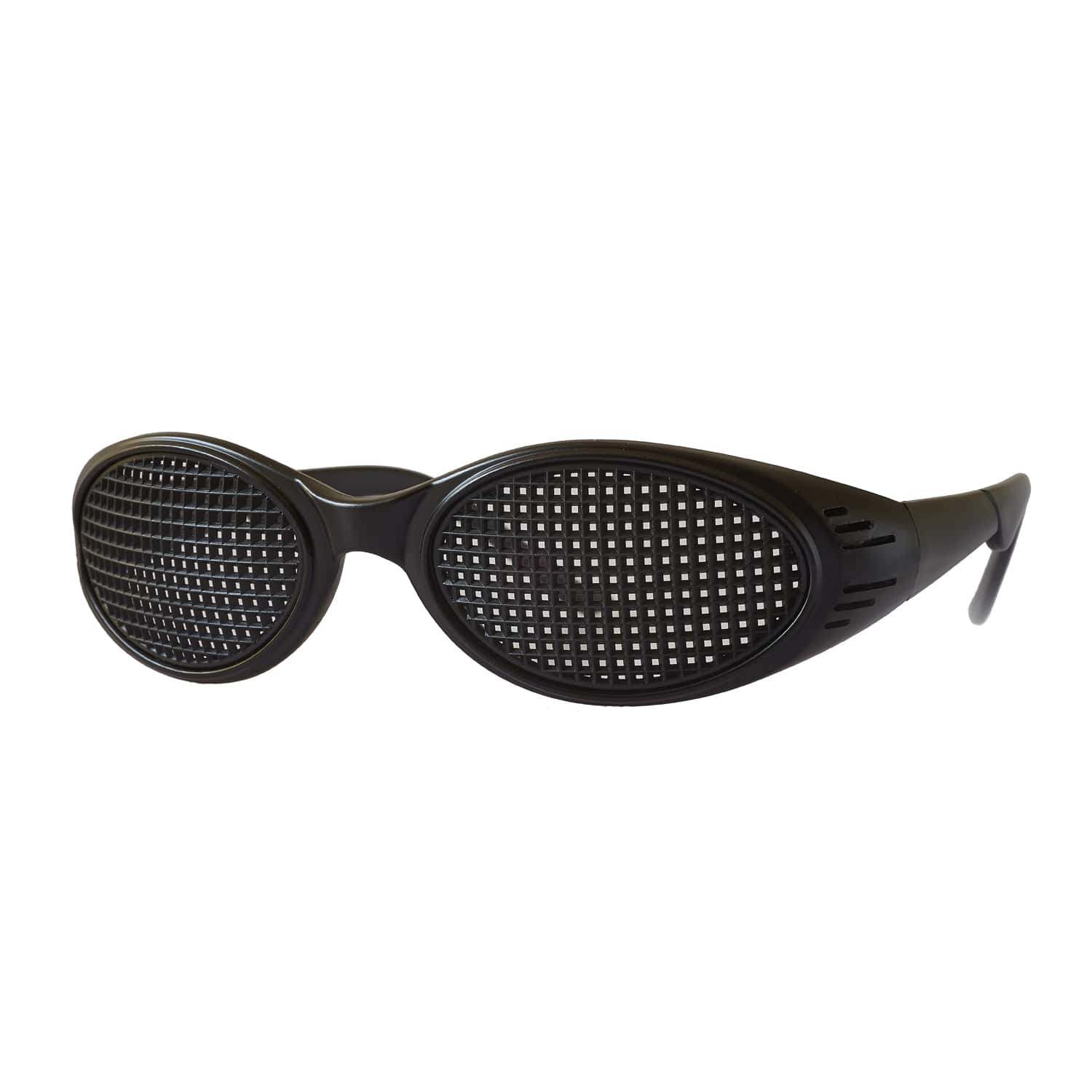
Pinhole Glasses KSP
DimensionsScope of deliveryFrame width: 140 mmPinhole GlassesArm length: 115 mmSpectacle caseBridge width: 20 mmOriginal Visus eye chart, the ideal aid for monitoring the progress of your eye trainingWeight: 20 gDetailed spectacle descriptionRaster height: 35 mmGrid length: 55 mmGrid: pyramidal grid A scratch-resistant, square grid arranged in a pyramid shape is integrated into curved lenses. Experience shows that this grid is preferred for prescriptions under 2.0 dioptres and serves as prevention for non-spectacle wearers. Use: Use the Pinhole Glasses or multidot glasses for 10–20 minutes every day. Long-sighted people wear them when reading, short-sighted people when watching television, using a computer screen or during activities that require distance vision. Benefits: Training with Pinhole Glasses supports natural vision. Thanks to the pinhole effect, you can see almost as clearly as with corrective glasses. At the same time, the brain activates the eye muscles, allowing sharpness to be achieved independently. Design: The black, slim-fit frames for men and women make a fashionable, sporty statement. Side light protection ensures optimal training sessions with the Multidot glasses. Maintaining eye health in our hectic times Traditional vision exercises are time-consuming and require disciplined practice. Training with grid or pinhole glasses is ideal for modern multitasking – you train your eyes while working on the computer, for example. Eye training – an intelligent alternative for visual impairments Modern working environments place a one-sided strain on the eyes – both in terms of light-dark adaptation and near-far focusing. Vision training with pinhole glasses breaks through this one-sidedness and supports natural vision. The origin of eye training according to William Bates William Bates proved that visual acuity does not primarily depend on the lens of the eye, but on the activity of the six external eye muscles. In 1920, he published his findings in ‘Perfect Sight Without Glasses’. Later, Janet Goodrich developed training methods for grid and pinhole glasses based on these findings. Additional product information: Manufacturer: BioTec Dr. Egely & Lobmayer GmbH, Sendlingerstr. 8, 84332 Hebertsfelden, Germany, Telephone: +49 8721 910939, Email: info@biotec7.de Warnings and safety instructions: Do not use in road traffic. Improper cleaning or aggressive cleaning agents can damage the glasses.
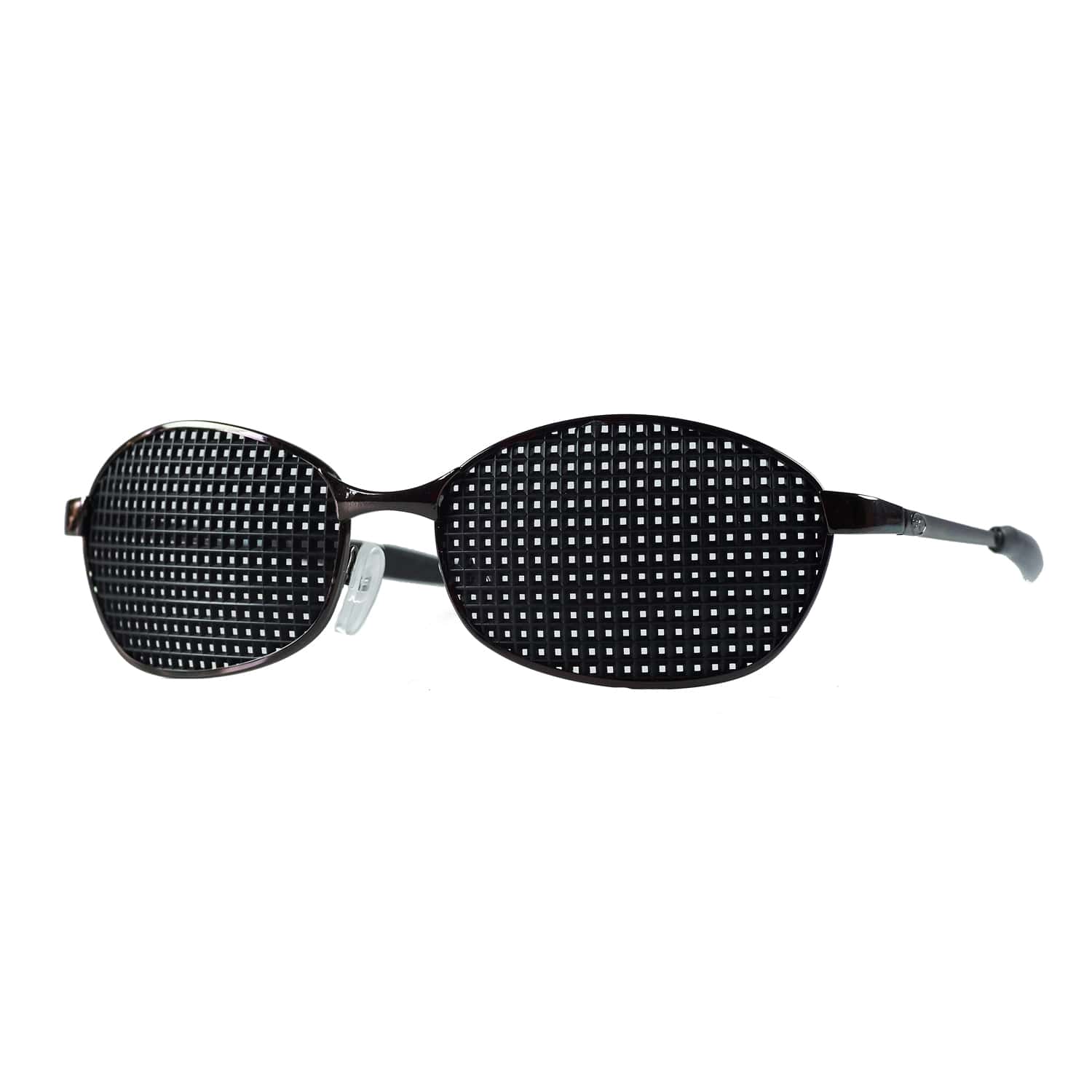
Pinhole Glasses LAP
DimensionsScope of deliveryFrame width: 140 mmPinhole GlassesTemple length: 130 mmSpectacle caseBridge width: 18 mmOriginal Visus eye chart, the ideal aid for monitoring the progress of your eye trainingWeight: 20 gDetailed spectacle descriptionRaster height: 35 mmGrid length: 58 mmGrid: pyramidal grid A scratch-resistant, square grid arranged in a pyramid shape is integrated into curved lenses. Experience shows that this grid is preferred for 2.0 dioptres and serves as prevention for non-spectacle wearers. Use: 10–20 minutes of daily vision training with Pinhole Glasses or multidot glasses will improve your eye function. For long-sightedness, we recommend using them when reading; for short-sightedness, when working at a screen, watching television or looking into the distance. Benefits: Pinhole Glasses use the pinhole effect to promote natural vision. The eye muscles are stimulated by signals from the brain to focus independently again – a process that is often impaired by conventional glasses. Design: The silver-anodised metal frame in optician quality offers high wearing comfort. The curved side lenses protect the eyes from scattered light. Unisex model with silicone nose pads and reinforced plastic ends. Maintaining eye health in our hectic times Traditional vision exercises are time-consuming and require disciplined practice. Training with grid or pinhole glasses is ideal for modern multitasking – you train your eyes while working on the computer, for example. Eye training – an intelligent alternative for visual impairments In the modern working world, our eyes are exposed to one-sided strain: adaptation (light-dark) and accommodation (near-far) are heavily stressed. Training with pinhole glasses breaks through this one-sidedness and supports natural vision. The origins of eye training according to William Bates William Bates proved that visual acuity does not primarily depend on the lens of the eye, but on the activity of the six external eye muscles. In 1920, he published his findings in ‘Perfect Sight Without Glasses’. Janet Goodrich later developed training methods for grid and pinhole glasses based on these findings. Additional product information: Manufacturer: BioTec Dr. Egely & Lobmayer GmbH, Sendlingerstr. 8, 84332 Hebertsfelden, Germany, Telephone: +49 8721 910939, Email: info@biotec7.de Warnings and safety instructions: Do not use in road traffic. Improper cleaning or aggressive cleaning agents can damage the glasses.

Pinhole Glasses PGP
Dimensions Scope of delivery Frame width: 130 mm Pinhole Glasses Arm length: 130 mm Spectacle case Bridge width: 18 mm Original Visus eye chart, the ideal aid for monitoring the progress of your eye training Weight: 15 g Detailed spectacle description Raster height: 45 mm Grid length: 54 mm Grid: pyramidal grid Scratch-resistant, square grid arranged in a pyramid shape on curved lenses. Experience shows that this full-surface grid is preferred for less than 2.0 dioptres and serves as prevention for non-spectacle wearers. Use: Integrate Pinhole Glasses or multidot glasses into your daily routine for 10 to 20 minutes per day. For long-sightedness, they are suitable for close-up tasks such as reading, and for short-sightedness, they are suitable for ‘eye jogging’ when looking into the distance – for example, when going for a walk or watching television. Benefits: Pinhole Glasses stimulate the eye to see actively again. The pinhole effect creates near-optical clarity, while the brain activates the eye muscles – a natural counterbalance to passive vision correction through lenses. Design: The aviator glasses – also known as pilot glasses – are perhaps the most famous classic among eyeglass frames. The unique combination of these iconic aviator glasses with the function of vision training glasses gives the model, which can be worn by both men and women, a particularly cool and casual touch in addition to its useful training application. Can also be used as sunglasses thanks to the darkening (no UV protection) of the grid. The trademarks: filigree, gold-coloured metal frame, teardrop-shaped grid lenses, a double bridge, silicone nose pads and reinforced plastic ends. Maintaining eye health in our hectic times Traditional eye exercises to strengthen vision are time-consuming and require disciplined practice to compensate for visual impairments in the long term. Training with pinhole glasses or pinhole glasses is well suited to modern ‘multitasking’. You can complete your daily training while doing other things, such as working on the computer. Eye training with pinhole glasses – an intelligent alternative for visual impairments In the modern and complex world of work, our eyes are exposed to one-sided strain on their adaptive capacity (problems with light-dark adjustment) and one-sided strain on their accommodative capacity (problems with near-far adjustment). These are usually the cause of declining vision or the development of vision problems. Vision training with pinhole glasses ‘breaks through’ this one-sidedness of vision. The eye learns to see naturally again. The origin of eye training according to William Bates William Bates, the forefather of eye training, proved through numerous experiments that vision can be retrained. According to his findings, it was not the lens of the eye that was responsible for ‘focusing’ and/or visual acuity, but rather the activity of the six external eye muscles. In 1920, he published his empirical findings in his classic work ‘Perfect Sight Without Glasses’. Based on his theory, Bates developed simple eye exercises for various visual impairments. This is known as the ‘Bates Method’. Later, the luminary among vision trainers, Janet Goodrich, built on the Bates Method and published the first studies on pinhole glasses or grid glasses. Additional product information: Manufacturer: BioTec Dr. Egely & Lobmayer GmbH, Sendlingerstr. 8, 84332 Hebertsfelden, Germany, Telephone: +49 8721 910939, Email: info@biotec7.de Warnings and safety instructions: Must not be used in road traffic. Unsuitable cleaning: The use of aggressive cleaning agents or improper handling can damage the glasses.

Pinhole Glasses SSP
DimensionsScope of deliveryFrame width: 135 mmPinhole GlassesTemple length: 140 mmSpectacle caseBridge width: 15 mmOriginal Visus eye chart, the ideal aid for monitoring the progress of your eye trainingWeight: 22 gDetailed spectacle descriptionRaster height: 40 mmGrid length: 70 mmGrid: pyramidal grid The curved lenses contain a scratch-resistant, square grid arranged in a pyramid shape. This full-surface grid is preferred for prescriptions under 2.0 dioptres and serves as a preventative measure for people who do not wear glasses. Use: The Pinhole Glasses or multidot glasses should be worn for 10–20 minutes a day during normal activities. Long-sighted people benefit when reading, while short-sighted people activate their vision when watching television, working at a computer screen or looking into the distance. Benefits: Pinhole Glasses support natural vision training. The pinhole effect enables almost sharp vision, while the brain stimulates the eye muscles so that the eye can focus independently again. Design: The shiny black plastic frame with silver-coloured decorative rivets at the top of the frame impresses with its high-quality workmanship. The model is unisex, offers high wearing comfort and gives the glasses an elegant look. Maintaining eye health in hectic times Traditional vision exercises are often time-consuming and require discipline. With pinhole glasses, training can be easily integrated into everyday life, e.g. while working on the computer. Eye training – an intelligent alternative for visual impairments Modern working environments place a one-sided strain on the eyes' ability to adapt and accommodate. Training with pinhole glasses breaks this one-sidedness and promotes natural vision. The origin of eye training according to William Bates William Bates proved that visual acuity is significantly influenced by the activity of the six external eye muscles. In 1920, he published his findings in ‘Perfect Sight Without Glasses’. The methods were further developed by Janet Goodrich and scientifically applied to grid and pinhole glasses. Additional product information: Manufacturer: BioTec Dr. Egely & Lobmayer GmbH, Sendlingerstr. 8, 84332 Hebertsfelden, Germany, Telephone: +49 8721 910939, Email: info@biotec7.de Warnings and safety instructions: Do not use in road traffic. Improper cleaning or aggressive cleaning agents can damage the glasses.

